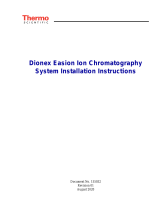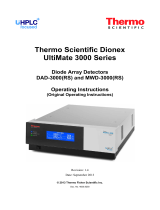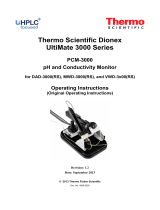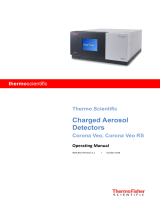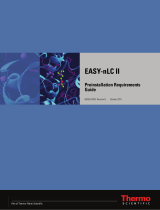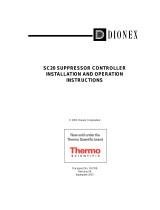La page est en cours de chargement...

Thermo Scientific
Dionex Aquion Ion
Chromatography System
Installation Instructions
22176-97002 Revision 02 June 2016

© 2016 Thermo Fisher Scientific Inc. All rights reserved.
Chromeleon and ERS are registered trademarks of Thermo Fisher Scientific Inc. in the United States.
Microsoft and Windows are registered trademarks of Microsoft Corporation in the United States and other
countries.
PEEK is a trademark of Victrex PLC. Rheodyne is a trademark of IDEX Health & Science LLC.
All other trademarks are the property of Thermo Fisher Scientific Inc. and its subsidiaries.
Thermo Fisher Scientific Inc. provides this document to its customers with a product purchase to use in the
product operation. This document is copyright protected and any reproduction of the whole or any part of this
document is strictly prohibited, except with the written authorization of Thermo Fisher Scientific Inc.
The contents of this document are subject to change without notice. All technical information in this
document is for reference purposes only. System configurations and specifications in this document supersede
all previous information received by the purchaser.
This document is not part of any sales contract between Thermo Fisher Scientific Inc. and a purchaser. This
document shall in no way govern or modify any Terms and Conditions of Sale, which Terms and Conditions of
Sale shall govern all conflicting information between the two documents.
Release history: Revision 01 released February 2016; initial release of instrument
Revision 02 released June 2016; support for auxiliary valve added
Software version: Chromeleon 7.2 SR4 and later
For Research Use Only. Not for use in diagnostic procedures.

Thermo Scientific Dionex Aquion Installation Instructions i
C
Preface . . . . . . . . . . . . . . . . . . . . . . . . . . . . . . . . . . . . . . . . . . . . . . . . . . . . . . . . . . . . . .iii
Related Documentation . . . . . . . . . . . . . . . . . . . . . . . . . . . . . . . . . . . . . . . . . . iii
Safety Information . . . . . . . . . . . . . . . . . . . . . . . . . . . . . . . . . . . . . . . . . . . . . . .iv
Safety and Special Notices . . . . . . . . . . . . . . . . . . . . . . . . . . . . . . . . . . . . . . . .iv
Safety Symbols . . . . . . . . . . . . . . . . . . . . . . . . . . . . . . . . . . . . . . . . . . . . . . . .iv
Regulatory Compliance . . . . . . . . . . . . . . . . . . . . . . . . . . . . . . . . . . . . . . . . . . . v
Notice on Lifting and Handling of Thermo Scientific Instruments . . . . . . . . . v
Notice on the Proper Use of Thermo Scientific Instruments . . . . . . . . . . . . . .vi
Notice on the Susceptibility to Electromagnetic Transmission. . . . . . . . . . . . .vi
WEEE Compliance . . . . . . . . . . . . . . . . . . . . . . . . . . . . . . . . . . . . . . . . . . . . .vi
Deionized Water Requirements for IC . . . . . . . . . . . . . . . . . . . . . . . . . . . . . . .viii
Contacting Us . . . . . . . . . . . . . . . . . . . . . . . . . . . . . . . . . . . . . . . . . . . . . . . . .viii
. . . . . . . . . . . . . . . . . . . . . . . . . . . . . . . . . . . . . . . . . . . . . . . . . . . . . . . . . . . . .viii
Chapter 1 Unpacking Instructions . . . . . . . . . . . . . . . . . . . . . . . . . . . . . . . . . . . . . . . . . . . . . . . . .1
Unpacking the Dionex Aquion . . . . . . . . . . . . . . . . . . . . . . . . . . . . . . . . . . . . . . 1
Unpacking the PC. . . . . . . . . . . . . . . . . . . . . . . . . . . . . . . . . . . . . . . . . . . . . . . . 3
Chapter 2 System Setup . . . . . . . . . . . . . . . . . . . . . . . . . . . . . . . . . . . . . . . . . . . . . . . . . . . . . . . . . .5
Facility Requirements . . . . . . . . . . . . . . . . . . . . . . . . . . . . . . . . . . . . . . . . . . . . . 5
Connecting an Autosampler (Optional) . . . . . . . . . . . . . . . . . . . . . . . . . . . . . . . 6
Connecting a Dionex AS-DV Autosampler . . . . . . . . . . . . . . . . . . . . . . . . . . . 7
Connecting a Dionex AS-AP Autosampler . . . . . . . . . . . . . . . . . . . . . . . . . . . 7
Setting Up Chromeleon . . . . . . . . . . . . . . . . . . . . . . . . . . . . . . . . . . . . . . . . . . . 8
Connecting to the Chromeleon PC. . . . . . . . . . . . . . . . . . . . . . . . . . . . . . . . . . 10
Connecting the Dionex Aquion Power Cord. . . . . . . . . . . . . . . . . . . . . . . . . . . 13
Configuring the Device Properties and Verifying Communication . . . . . . . . . . 14
Chapter 3 Plumbing. . . . . . . . . . . . . . . . . . . . . . . . . . . . . . . . . . . . . . . . . . . . . . . . . . . . . . . . . . . . .17
Installing and Plumbing the Columns and Suppressor. . . . . . . . . . . . . . . . . . . . 17
Connecting the Waste Lines . . . . . . . . . . . . . . . . . . . . . . . . . . . . . . . . . . . . . . . 22
Setting Up the Eluent Reservoir . . . . . . . . . . . . . . . . . . . . . . . . . . . . . . . . . . . . 24
Setting the Eluent Level. . . . . . . . . . . . . . . . . . . . . . . . . . . . . . . . . . . . . . . . . . . 24
Priming the Pump. . . . . . . . . . . . . . . . . . . . . . . . . . . . . . . . . . . . . . . . . . . . . . . 25
Equilibrating the System . . . . . . . . . . . . . . . . . . . . . . . . . . . . . . . . . . . . . . . . . . 28
Contents

Contents
ii Dionex Aquion Installation Instructions Thermo Scientific
Verifying Operational Status . . . . . . . . . . . . . . . . . . . . . . . . . . . . . . . . . . . . . . . 28
Connecting the Analog Output (Optional) . . . . . . . . . . . . . . . . . . . . . . . . . . . . 29
Pressurizing the Eluent Reservoir (Optional). . . . . . . . . . . . . . . . . . . . . . . . . . . 30
Connecting the Gas Source . . . . . . . . . . . . . . . . . . . . . . . . . . . . . . . . . . . . . . 30
Applying the Pressure . . . . . . . . . . . . . . . . . . . . . . . . . . . . . . . . . . . . . . . . . . 30
Connecting the Pump Continuous Seal Wash (Optional) . . . . . . . . . . . . . . . . . 31

Thermo Scientific Dionex Aquion Installation Instructions iii
P
Preface
This manual provides instructions for the initial and successful installation of the Thermo
Scientific™ Dionex™ Aquion Ion Chromatography System. Follow the installation
instructions in this manual, in the order presented.
Related Documentation
In addition to this manual, these related documents are provided on the Thermo Scientific
Reference Library DVD (P/N 60-053891):
•Dionex Aquion Ion Chromatography System Operator’s Manual
(Document No. 22176-97003)
•Dionex AS-AP Autosampler Operator’s Manual (Document No. 065361)
•Dionex AS-DV Autosampler Operator’s Manual (Document No. 065259)
• Manuals for consumable products (columns, suppressors, CR-TC)
• Chromeleon 7 Installation Guide (Document No. 7229.0003)
Contents
•Related Documentation
•Safety Information
•Regulatory Compliance
•Deionized Water Requirements for IC
•Contacting Us

Preface
iv Dionex Aquion Installation Instructions Thermo Scientific
Safety Information
The Dionex Aquion was manufactured by Thermo Fisher Scientific at the following location:
Thermo Finnigan LLC 355 River Oaks Parkway, San Jose, CA 95134 USA. The Dionex
Aquion is designed for IC (ion chromatography) applications and should not be used for any
other purpose. Operation of a Dionex Aquion in a manner not specified by Thermo Fisher
Scientific may result in personal injury.
If there is a question regarding appropriate usage, contact Technical Support for Dionex
products. In the U.S. and Canada, call 1-800-532-4752. Outside the U.S. and Canada, call
the nearest Thermo Fisher Scientific office.
Safety and Special Notices
Make sure you follow the precautionary statements presented in this guide. The safety and
other special notices appear in boxes.
Safety and special notices include the following:
Safety Symbols
These symbols appear on the Dionex Aquion or on labels affixed to the system:
Alternating current
Primary protective conductor terminal
Secondary protective conductor terminal
Power supply is on
CAUTION Highlights hazards to humans, property, or the environment. Each CAUTION
notice is accompanied by an appropriate CAUTION symbol.
IMPORTANT Highlights information necessary to prevent damage to the system or
software, loss of data, or invalid test results; or might contain information that is critical
for optimal performance of the system.
Note Highlights information of general interest.
Tip Highlights helpful information that can make a task easier.

Preface
Thermo Scientific Dionex Aquion Installation Instructions v
Power supply is off
Indicates a potential hazard. Refer to this manual for an explanation of the
hazard and how to proceed.
Regulatory Compliance
Thermo Fisher Scientific performs complete testing and evaluation of its products to ensure
full compliance with applicable domestic and international regulations. When the system is
delivered to you, it meets all pertinent electromagnetic compatibility (EMC) and safety
standards as described in this section.
Changes that you make to your system may void compliance with one or more of these EMC
and safety standards. Changes to your system include replacing a part or adding components,
options, or peripherals not specifically authorized and qualified by Thermo Fisher Scientific.
To ensure continued compliance with EMC and safety standards, replacement parts and
additional components, options, and peripherals must be ordered from Thermo Fisher
Scientific or one of its authorized representatives.
The regulatory symbols on the model/data label of the Dionex Aquion Ion Chromatography
System indicate that the system is in compliance with the following Safety and EMC
standards:
• EN 61010-1:2010
• UL 61010-1:2012
• CAN/CSA-C22.2 No. 61010-1-12
• EN 61326-1:2013
The CE mark on the model/data label of the Dionex Aquion Ion Chromatography System
indicates that the system is in compliance with the following European Community
Directives as is evidenced by compliance to the associated standard where appropriate:
• Low Voltage/Safety Directive: 2014/35/EU by conforming to EN61010-1:2013
(3rd edition)
• EMC Directive: 2014/30/EU by conforming to EN61326-1:2013 (3rd edition)
Notice on Lifting and Handling of Thermo Scientific Instruments
For your safety, and in compliance with international regulations, the physical handling of
this Thermo Fisher Scientific instrument requires a team effort to lift and/or move the
instrument. This instrument is too heavy and/or bulky for one person alone to handle safely.

Preface
vi Dionex Aquion Installation Instructions Thermo Scientific
Notice on the Proper Use of Thermo Scientific Instruments
In compliance with international regulations: This instrument must be used in the manner
specified by Thermo Fisher Scientific to ensure protections provided by the instrument are
not impaired. Deviations from specified instructions on the proper use of the instrument
include changes to the system and parts replacement. Accordingly, order replacement parts
from Thermo Fisher Scientific or one of its authorized representatives.
Notice on the Susceptibility to Electromagnetic Transmission
Your instrument is designed to work in a controlled electromagnetic environment. Do not use
radio frequency transmitters, such as mobile phones, in close proximity to the instrument.
For manufacturing location, see the label on the instrument.
WEEE Compliance
This product complies with the European Union’s Waste Electrical & Electronic Equipment
(WEEE) Directive 2002/96/EC. It is marked with the following symbol:
Thermo Fisher Scientific is registered with B2B Compliance (B2Bcompliance.org.uk) in the
UK and with the European Recycling Platform (ERP-recycling.org) in all other countries of
the European Union and in Norway.
If this product is located in Europe and you want to participate in the Thermo Fisher
Scientific Business-to-Business (B2B) Recycling Program, send an email request to
weee.recycle@thermofisher.com with the following information:
• WEEE product class
• Name of the manufacturer or distributor (where you purchased the product)
• Number of product pieces, and the estimated total weight and volume
• Pick-up address and contact person (include contact information)
• Appropriate pick-up time
• Declaration of decontamination, stating that all hazardous fluids or material have been
removed from the product
For additional information about the Restriction on Hazardous Substances (RoHS) Directive
for the European Union, search for RoHS on the Thermo Fisher Scientific European language
websites.

Preface
Thermo Scientific Dionex Aquion Installation Instructions vii
Conformité DEEE
Ce produit est conforme avec la directive européenne (2002/96/EC) des Déchets
d'Equipements Electriques et Electroniques (DEEE). Il est marqué par le symbole suivant:
Thermo Fisher Scientific s'est associé avec une ou plusieurs sociétés de recyclage dans chaque
état membre de l’Union Européenne et ce produit devrait être collecté ou recyclé par
celle(s)-ci. Pour davantage d'informations, rendez-vous sur la page
www.thermoscientific.fr/rohs.
WEEE Konformität
Dieses Produkt entspricht der EU Waste Electrical & Electronic Equipment (WEEE)
Richtlinie 2002/96/EC. Es ist mit dem folgenden Symbol gekennzeichnet:
Thermo Fisher Scientific hat Vereinbarungen mit Verwertungs-/Entsorgungsfirmen in allen
EU-Mitgliedsstaaten getroffen, damit dieses Produkt durch diese Firmen wiederverwertet
oder entsorgt werden kann. Weitere Informationen finden Sie unter
www.thermoscientific.de/rohs.

Preface
viii Dionex Aquion Installation Instructions Thermo Scientific
Deionized Water Requirements for IC
For eluent generation or when manually preparing eluent and regenerant, use ASTM Type I
(18 megohm-cm) filtered and deionized water that meets the specifications listed in Table 1.
Contacting Us
For Technical Support for Dionex products
In the U.S. and Canada, call 1-800-532-4752.
Outside the U.S. and Canada, call the nearest Thermo Fisher Scientific office.
For additional contact information
Go to www.thermofisher.com/us/en/home/technical-resources/contact-us.html.
Table 1. ASTM filtered, Type I deionized water specifications for ion chromatography
Contaminant Specification
Ions–Resistivity >18.0 (megohm-cm)
Organics–TOC <10 ppb
Iron/Transition Metals* <1 ppb
Pyrogens <0.03 (Eu/mL)
Particulates > 0.2 μm <1 (units/mL)
Colloids–Silica <10 ppb
Bacteria <1 (cfu/mL)
* Iron/transition metal content not specified for ASTM Type I water

CAUTION Symbol CAUTION VORSICHT PRECAUCIÓN MISE EN GARDE
Risk electric shock: This instrument uses
voltages that can cause electric shock and/or
personal injury. Before servicing, shut down the
instrument and disconnect it from line power.
While operating the instrument, keep covers on.
Do not remove the protective covers from the
printed circuit board assemblies (PCBAs).
Stromschlaggefahr: Dieses Gerät arbeitet mit
Spannungen, die Stromschläge und/oder
Personenverletzungen verursachen können. Vor
Wartungsarbeiten muss das Gerät abgeschaltet
und vom Netz getrennt werden. Betreiben Sie das
Gerät nicht mit abgenommenen Abdeckungen.
Nehmen Sie die Schutzabdeckungen von
Leiterplatten nicht ab.
Riesgo de descargas eléctricas: Este instrumento
utiliza voltajes que pueden causar descargas
eléctricas y/o lesiones personales. Antes de revisar o
reparar el instrumento, apáguelo y desconéctelo de la
red eléctrica. Mantenga colocadas las cubiertas
mientras se utiliza el instrumento. No retire las
cubiertas protectoras del circuito impreso completo
(PCBA).
Risque de choc électrique : l’instrument utilise des
tensions susceptibles de provoquer une électrocution
et/ou des blessures corporelles. Il doit être arrêté et
débranché de la source de courant avant toute
intervention. Ne pas utiliser l’instrument sans ses
couvercles. Ne pas enlever les capots de protection des
cartes à circuit imprimé (PCBA).
Chemical hazard: Wear gloves and other
protective equipment, as appropriate, when
handling toxic, carcinogenic, mutagenic, corrosive,
or irritant chemicals. Use approved containers and
proper procedures to dispose of waste oil and
when handling wetted parts of the instrument.
Gefahr durch Chemikalien: Tragen Sie beim
Umgang mit toxischen, karzinogenen, mutagenen,
ätzenden oder reizenden Chemikalien
Schutzhandschuhe und weitere geeignete
Schutzausrüstung. Verwenden Sie bei der
Entsorgung von verbrauchtem Öl und beim Umgang
mit medienberührenden Komponenten die
vorgeschriebenen Behälter, und wenden Sie
ordnungsgemäße Verfahren an.
Peligro por sustancias químicas: Cuando
manipule sustancias químicas, tóxicas,
carcinogénicas, mutágenas, corrosivas o irritantes,
utilice guantes y otro equipo de protección. Utilice
siempre recipientes homologados y siga los
procedimientos adecuados cuando deseche aceite
residual o manipule partes mojadas del instrumento.
Danger lié aux produits chimiques : porter des gants
et d’autres équipements de protection appropriés pour
manipuler les produits chimiques toxiques, cancérigènes,
mutagènes, corrosifs ou irritants. Utiliser des récipients
homologués et des procédures adéquates pour la mise au
rebut des huiles usagées et lors de la manipulation des
pièces de l’instrument en contact avec l’eau.
Hot surface: Before touching, allow any heated
components to cool.
Heiße Oberflächen: Lassen Sie heiße
Komponenten vor der Berührung abkühlen.
Superficies calientes: Antes de tocar los
componentes calientes, espere a que se enfríen.
Surface chaude : laisser refroidir les composants
chauffés avant toute manipulation.
Flammable substances hazard: Use care when
operating the system in the presence of flammable
substances.
Gefahr durch entzündbare Substanzen:
Beachten Sie die einschlägigen Vorsichtsmaßnahmen,
wenn Sie das System in Gegenwart von entzündbaren
Substanzen betreiben.
Peligro por sustancias inflamables: Tenga mucho
cuidado cuando utilice el sistema cerca de sustancias
inflamables.
Danger lié aux substances inflammables : agir avec
précaution lors de l’utilisation du système en présence de
substances inflammables.
Risk of eye injury: Eye injury could occur from
splattered chemicals, airborne particles, or sharp
objects. (Sharp objects that customers might install
in the instrument include fused-silica tubing, the
autosampler needle, and so on.) Wear safety
glasses when handling chemicals or servicing the
instrument.
Augenverletzungsrisiko: Verspritzte
Chemikalien, Schwebstoffpartikel oder scharfe
Objekte können Augenverletzungen verursachen.
(Scharfe Objekte, die Kunden möglicherweise im
Gerät installieren, sind z. B. Quarzglas-Kapillaren,
die Nadel des Autosamplers, usw.) Tragen Sie beim
Umgang mit Chemikalien oder bei der Wartung des
Gerätes eine Schutzbrille.
Riesgo de lesiones oculares: Las salpicaduras de
sustancias químicas, las partículas flotantes en el
aire y los objetos afilados pueden causar lesiones
oculares. (Entre los objetos afilados que los clientes
pueden instalar en el instrumento se encuentran
tubos de sílice fundida, agujas del muestreador
automático, etc.). Para manipular sustancias
químicas o realizar tareas de mantenimiento, utilice
gafas de seguridad.
Risque de lésion oculaire : les projections chimiques,
les particules en suspension dans l’air et les objets
tranchants peuvent entraîner des lésions oculaires. (Les
objets tranchants pouvant être installés par les clients
dans l’instrument comprennent les tubes en silice fondue,
les aiguilles du passeur automatique, etc.). Porter des
lunettes de protection lors de toute manipulation de
produit chimique ou intervention sur l’instrument.
General hazard: A hazard is present that is not
included in the other categories. This symbol also
appears on the instrument. For details about the
hazard, refer to the instrument manual.
When the safety of a procedure is questionable,
contact Technical Support for Thermo Scientific
Sunnyvale products.
Allgemeine Gefahr: Es besteht eine weitere
Gefahr, die nicht in den vorstehenden Kategorien
beschrieben ist. Dieses Symbol wird auch auf dem
Gerät angebracht. Einzelheiten zu dieser Gefahr
finden Sie in den Gerätehandbüchern.
Wenn Sie sich über die Sicherheit eines Verfahrens
im Unklaren sind, setzen Sie sich, bevor Sie
fortfahren, mit dem technischen Support für
Thermo Scientific Sunnyvale Produkte in
Verbindung.
Peligro general: Existen peligros que no se incluyen
en las otras categorías. Este símbolo también
aparece en el instrumento. Si desea obtener más
información sobre estos peligros, consulte el manual
del instrumento.
En caso de duda sobre la seguridad de un procedimiento,
póngase en contacto con el personal de servicio técnico
de los productos Thermo Scientific Sunnyvale.
Danger d’ordre général : indique la présence d’un
risque n’appartenant pas aux catégories citées plus haut.
Ce symbole figure également sur l’instrument. Pour plus
de détails sur ce danger potentiel, se reporter au manuel
de l’instrument.
Si la sûreté d’une procédure est incertaine, contacter
l’assistance technique pour les produits Thermo Scientific
Sunnyvale.

Laser hazard: This instrument uses a laser that is
capable of causing personal injury. This symbol
also appears on the instrument. For details about
the hazard, refer to the instrument manual.
Gefahr durch Laserstrahlen: Der in diesem Gerät
verwendete Laser kann zu Verletzungen führen.
Dieses Symbol wird auch auf dem Gerät
angebracht. Einzelheiten zu dieser Gefahr finden
Sie in den Gerätehandbüchern.
Peligro por láser: Este instrumento utiliza un láser
que puede producir lesiones personales. Este símbolo
también aparece en el instrumento. Si desea obtener
más información sobre el peligro, consulte el manual
del instrumento.
Danger lié au laser : l’instrument utilise un laser
susceptible de provoquer des blessures corporelles. Ce
symbole figure également sur l’instrument. Pour plus de
détails sur ce danger potentiel, se reporter au manuel de
l’instrument.
Ultra violet light hazard: Do not look directly at
the ultra-violet (UV) light or into the UV source.
Exposure can cause eye damage. Wear UV eye
protection.
Gefahr durch UV-Licht: Richten Sie Ihren Blick
nicht direkt auf ultraviolettes Licht (UV-Licht) oder
in die UV-Quelle. Dies kann zu Augenschäden
führen. Tragen Sie eine UV-Schutzbrille.
Peligro por luz ultravioleta: No mire directamente
a una luz ultravioleta (UV) ni a una fuente UV. La
exposición puede causar daños oculares. Lleve
protección ocular para UV.
Danger lié aux rayons ultraviolets : ne jamais
regarder directement la lumière ultraviolette (UV) ou la
source d’UV. Une exposition peut entraîner des lésions
oculaires. Porter des protections oculaires anti-UV.
Sharp object: Avoid physical contact with the
object.
Scharfes Objekt: Vermeiden Sie den physischen
Kontakt mit dem Objekt.
Objeto puntiagudo: Evite el contacto físico con el
objeto.
Objet tranchant : éviter tout contact physique avec
l’objet.
Pinch point: Keep hands away from this area. Quetschgefahr: Halten Sie Ihre Hände von diesem
Bereich fern.
Puntos de pinzamiento: Mantenga las manos
apartadas de esta área.
Risque de pincement : éloigner les mains de cette zone.
Heavy objects: Never lift or move the instrument
by yourself; you can suffer personal injury or
damage the equipment. For specific lifting
instructions, refer to the instrument manual.
Schweres Objekt: Bewegen und heben Sie das
Gerät niemals allein an; dies kann zu Verletzungen
oder zur Beschädigung des Geräts führen.
Spezifische Anweisungen zum Anheben finden Sie
im Gerätehandbuch.
Objeto pesado: Nunca levante ni mueva el
instrumento por su cuenta, podría sufrir lesiones
personales o dañar el equipo. Para obtener
instrucciones específicas sobre levantamiento,
consulte el manual del instrumento.
Objet lourd : ne jamais soulever ou déplacer l’instrument
seul sous peine de blessure corporelle ou
d’endommagement de l’instrument. Pour obtenir des
instructions de levage spécifiques, se reporter au manuel
de l’instrument.
Trip obstacle: Be aware of cords, hoses, or other
objects located on the floor.
Stolpergefahr: Achten Sie auf Kabel, Schläuche
und andere Objekte auf dem Fußboden.
Tropiezo con obstáculos: Tenga en cuenta los cables,
mangueras u otros objetos colocados en el suelo.
Risque de trébuchement : faire attention aux câbles,
tuyaux et autres objets situés sur le sol.
When the safety of a procedure is questionable,
contact Technical Support for Thermo Scientific
Sunnyvale products.
Wenn Sie sich über die Sicherheit eines Verfahrens
im unklaren sind, setzen Sie sich, bevor Sie
fortfahren, mit Ihrer lokalen technischen
Unterstützungsorganisation für Thermo Scientific
Sunnyvale Produkte in Verbindung.
En caso de duda sobre la seguridad de un procedimiento,
póngase en contacto con el personal de servicio técnico
de los productos Thermo Scientific Sunnyvale.
Si la sûreté d’une procédure est incertaine, contacter
l’assistance technique pour les produits Thermo Scientific
Sunnyvale.
CAUTION Symbol CAUTION VORSICHT PRECAUCIÓN MISE EN GARDE

CAUTION Symbol CAUTION 警告 危险警告
Risk electric shock: This instrument
uses voltages that can cause electric
shock and/or personal injury. Before
servicing, shut down the instrument and
disconnect it from line power. While
operating the instrument, keep covers on.
Do not remove the protective covers from
the printed circuit board assemblies
(PCBAs).
感電の危険性 : この機器では、感電および /または身体傷害を引き起こ
すおそれのある電圧を使用しています。整備点検の前には、機器の電
源を切り、電源コードを抜いてください。機器の作動中は、カバーを
付けたままにしてください。プリント基板アセンブリ (PCBA) から保護
カバーを取り外さないでください。
触电危险:本仪器所用电压可能导致电击或人身伤害。进行维修服务
前,务必关闭仪器电源并断开其电源连接。操作此仪器时,不要卸下
顶盖。勿卸下印刷电路板组件 (PCBA)的保护盖。
Chemical hazard: Wear gloves and
other protective equipment, as
appropriate, when handling toxic,
carcinogenic, mutagenic, corrosive, or
irritant chemicals. Use approved
containers and proper procedures to
dispose of waste oil and when handling
wetted parts of the instrument.
化学的危険性 : 毒性、発癌性、変異原性、腐食性、または刺激性のある
化学薬品を取り扱うときは、必要に応じて手袋などの保護具を着用し
ます。廃油を処分したり、機器の接液部品を取り扱うときは、認可さ
れた容器を使用し、適切な手順に従います。
化学品危险:当处理毒性、致癌性、致突变性、腐蚀性或者刺激性化学
品时,佩戴手套和其他保护性设备。当处理浸湿的仪器部件以及废油
时,使用认可的容器和合适的步骤。
Hot surface: Before touching, allow any
heated components to cool.
高温面 : 触れる前に、加熱した部品を冷ましてください。 热表面:待高温部件冷却之后再进行维修。
Flammable substances hazard: Use
care when operating the system in the
presence of flammable substances.
可燃性物質の危険性 :可燃性物質があるところでシステムを作動させる
場合は十分注意してください。
易燃物危险:在有易燃物质的场地操作该系统时,务必小心谨慎。
Risk of eye injury: Eye injury could occur
from splattered chemicals, airborne
particles, or sharp objects. (Sharp objects
that customers might install in the
instrument include fused-silica tubing, the
autosampler needle, and so on.) Wear
safety glasses when handling chemicals
or servicing the instrument.
眼外傷の危険性 : 飛散した化学薬品、浮遊粒子、または鋭利な物体に
よって眼外傷を負うおそれがあります (機器に取り付けられる可能性が
ある鋭利な物体は、ヒューズドシリカ、オートサンプラーニードルな
どです )。化学薬品を取り扱ったり、機器を整備点検するときは、保護
メガネを着用します。
眼睛伤害风险:眼睛受伤可能源自飞溅的化学品、空气中的颗粒,
或者锋利的物体。(安装在仪器内的锋利物体包括熔融石英管、
自动进样器的进样针等。)处理化学品或对仪器进行维修服务时,
务必戴上防护眼镜。
General hazard: A hazard is present that
is not included in the other categories.
This symbol also appears on the
instrument. For details about the hazard,
refer to the instrument manual.
When the safety of a procedure is
questionable, contact Technical Support
for Thermo Scientific Sunnyvale products.
一般的な危険性 :それぞれのカテゴリーに当てはまらない危険がありま
す。この標識記号は機器にも表示されています。この危険の詳細につい
ては、機器のマニュアルを参照してください。
手順の安全性にご不明な点がある場合は、Thermo Scientific Sunnyvale 製品の
テクニカルサポートまでお問い合わせください。
普通危险:未归入其他类别的危险。此符号也会在仪器上出现。有关此
危险的详细信息,参阅适当的仪器手册。若对任何步骤的安全事项有疑
问,联系 Thermo Scientific Sunnyvale 产品的技术支持中心。

Laser hazard: This instrument uses a
laser that is capable of causing personal
injury. This symbol also appears on the
instrument. For details about the hazard,
refer to the instrument manual.
レーザー光線の危険性 :この機器では、身体傷害を引き起こすおそれ
のあるレーザーを使用しています。この標識記号は機器にも表示され
ています。この危険の詳細については、機器のマニュアルを参照して
ください。
激光危险:本仪器所用激光会导致人身伤害。此符号也会在仪器上出
现。有关此危险的详细信息,参阅适当的仪器手册。
Ultra violet light hazard: Do not look
directly at the ultra-violet (UV) light or into
the UV source. Exposure can cause eye
damage. Wear UV eye protection.
紫外光の危険性 :紫外 (UV) 光または UV 光源を直接見ないでください。照
射によって眼損傷を引き起こすおそれがあります。UV 保護メガネを着用
します。
紫外光危险:不要直视紫外 (UV)光或者紫外光源。直视可能导致眼
睛伤害。佩戴紫外线防护眼镜。
Sharp object: Avoid physical contact
with the object.
鋭利な物体 :物体との身体的接触を避けてください。 锋利物体:避免直接接触锋利的物体。
Pinch point: Keep hands away from this
area.
ピンチポイント :この部分には手を挟まれないようにしてください。 夹点:勿将手放在此部位。
Heavy objects: Never lift or move the
instrument by yourself; you can suffer
personal injury or damage the equipment.
For specific lifting instructions, refer to the
instrument manual.
重量物 :1 人で機器を持ち上げたり移動しないでください。身体傷害を
負ったり、機器を損傷するおそれがあります。具体的な持ち上げ方法
については、機器のマニュアルを参照してください。
重物:切勿独自提起或移动本仪器;可能遭受人身伤害或损坏仪器。
有关具体的提起说明,参阅仪器手册。
Trip obstacle: Be aware of cords, hoses,
or other objects located on the floor.
作業の障害物 :床にあるコード、ホース、その他の物体に注意してく
ださい。
绊倒危险:注意地面上的线、管或其他物品。
When the safety of a procedure is
questionable, contact Technical Support
for Thermo Scientific Sunnyvale products.
手順の安全性にご不明な点がある場合は、Thermo Scientific Sunnyvale 製品の
テクニカルサポートまでお問い合わせください。
如对安全程序有疑问,联系 Thermo Scientific Sunnyvale 产品的技术支持
中心。
CAUTION Symbol CAUTION 警告 危险警告

Thermo Scientific Dionex Aquion Installation Instructions 1
1
Unpacking Instructions
.
Unpacking the Dionex Aquion
Contents
•Unpacking the Dionex Aquion
•Unpacking the PC
CAUTION Two or more persons must lift the Dionex Aquion, which weighs more than
23 kg (50 lb). Lift the Dionex Aquion only from each side of the cabinet bottom. Lifting
from the front door will damage the door hinges.
MISE EN GARDE Au moins deux personnes doivent soulever le Dionex Aquion, qui pèse
plus de 23 kg (50 lb). Ne soulevez le Dionex Aquion que par chaque côté du fond de
l’appareil. Son soulèvement par la porte du panneau avant endommagera les charnières de
la porte.
VORSICHT Der Dionex Aquion wiegt über 23 kg. Daher darf das Gerät nur von zwei
oder mehr Personen angehoben werden. Greifen Sie dazu an beiden Seiten unter das
Gerät. Wenn Sie den Dionex Aquion an der Vordertür anheben, werden die Scharniere
der Tür beschädigt.

1 Unpacking Instructions
Unpacking the Dionex Aquion
2Dionex Aquion Installation Instructions Thermo Scientific
1. Open the shipping box and remove the top layer of foam (see Figure 1).
Figure 1. Shipping box open
2. Open the plastic bag that covers the system (see Figure 2).
Figure 2. Dionex Aquion enclosed in bag
3. Set the eluent bottle on top of the system (see Figure 3).
Figure 3. Dionex Aquion with eluent bottle
Remove this foam.
Eluent bottle

1 Unpacking Instructions
Unpacking the PC
Thermo Scientific Dionex Aquion Installation Instructions 3
4. Remove the next layer of foam (see Figure 4).
Figure 4. Shipping box with middle layer of foam removed
5. Lift the system from the seating/cavity of the foam to the top of the foam. Reach down to
the bottom of the system, lift it out of the box, and set it on the workbench.
6. Inspect the system for any shipping damage. Save the shipping container and all packing
material. You will need them in the future if the system is shipped.
Unpacking the PC
1. Remove the PC and all documentation from the PC box and place them on a workbench.
2. Follow the instructions in the PC installation guide to connect the PC components.

1 Unpacking Instructions
Unpacking the PC
4Dionex Aquion Installation Instructions Thermo Scientific

Thermo Scientific Dionex Aquion Installation Instructions 5
2
System Setup
This chapter provides instructions for setting up the Dionex Aquion and Thermo Scientific™
Dionex™ Chromeleon™ 7 Chromatography Data System software. These instructions apply to
systems configured with a conductivity detector. After completing the setup steps, refer to the
plumbing instructions for your detection type.
Facility Requirements
Contents
•Facility Requirements
•Connecting an Autosampler (Optional)
•Setting Up Chromeleon
•Connecting to the Chromeleon PC
•Connecting the Dionex Aquion Power Cord
•Configuring the Device Properties and Verifying Communication
CAUTION Do not pressurize the eluent reservoir above 0.07 MPa (10 psi).
MISE EN GARDE Ne mettez jamais les réservoirs d'éluants sous une pression supérieure à
0,07 MPa (10 lb/po²).
VORSICHT Setzen Sie den Eluentbehälter auf keinen Fall einem Druck über 0,07 MPa
aus.

2 System Setup
Connecting an Autosampler (Optional)
6Dionex Aquion Installation Instructions Thermo Scientific
• Verify that the installation site meets these environmental specifications:
–Main Power: 100 to 240 Vac, 50 to 60 Hz (auto-sensing power supply; no manual
voltage or frequency adjustment required)
–Operating Temperature: 4 to 40 °C (40 to 104 °F)
–Humidity: 5% to 95% relative humidity, noncondensing
• Provide a sturdy workbench for the system. The workbench should be high enough to
allow convenient access to the interior of the Dionex Aquion.
• Allow at least 15 cm (6 in) behind the system for power connections and ventilation. For
optimal performance, install the system in a draft-free location, out of the path of air
conditioning and heating vents.
• Use ASTM filtered, Type I (18-megohm) deionized water when preparing eluent and
regenerant (see “Deionized Water Requirements for IC” on page viii).
• (Optional) For pressurization of the eluent reservoir, provide a clean gas source regulated
to between 0.55 and 0.83 MPa (80 and 120 psi). An air regulator accessory
(P/N 060054) is required to regulate the pressure to between 0.03 and 0.04 MPa
(5 and 6 psi).
Connecting an Autosampler (Optional)
To connect a Thermo Scientific™ Dionex™ AS-DV Autosampler or Thermo Scientific™
Dionex™ AS-AP Autosampler to the injection valve in the Dionex Aquion, follow the
instructions in the appropriate section below.
Auxiliary Valve (Optional)
Thermo Fisher Scientific offers a high-pressure Rheodyne™ valve as an auxiliary valve for the
Dionex Aquion. The electrically-activated, 2-position PEEK™ valve is offered in both 6-port
and 10-port (0.010-in ports or 0.020-in ports) models. The auxiliary valve must be installed
on-site by Thermo Fisher Scientific field service personnel.
When the auxiliary valve is installed in the Dionex Aquion, it can be used as the injection
valve instead of the standard valve configured with the system.
/
